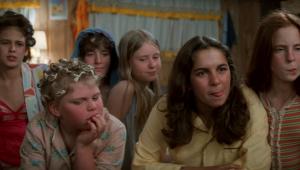Review: Sharp XV-Z17000 3D DLP projector Page 2
Performance
I have never seen a single-chip DLP projector put out a picture this bright. As soon as it came out of the box, with the irises open and the lamp in High Brightness mode, I got an astounding 36 footlamberts on a 102-inch, 1.0-gain screen. I’ve reviewed extremely bright $30,000 three-chip DLPs that this beats by nearly 15%.
Such exceptional performance in one area quite often comes at the expense of another area. In the case of the XV-Z17000, this manifests itself as rather significant color inaccuracy. (See Test Bench for details.) Most noticeably, lips look a little too red, and grass isn’t totally lifelike. There are two color management settings that let you pick a color and adjust it. This had minimal effect, and with only two settings available, one color was still going to be left out regardless. I tend to be a stickler for accurate color, but if you’re not, then this may not bother you.
If you expected the other cost of such extreme light output to be a poor black level, you’re sort of correct. Three mechanisms here attempt to harness the sun: an Eco+Quiet lamp mode that drops the projector’s light output by a little over 45% and two separate iris controls. The first is a manual job, with High Brightness and High Contrast settings. (The latter dims brightness by an additional 20 to 25%.) To put the XV-Z17000’s light output in perspective, with its lamp set to Eco+Quiet and its iris to High Contrast, it’s still brighter than the Epson 9700UB projector I reviewed in the January issue.
The second iris, appropriately labeled Auto, monitors the video signal and closes during dark scenes to make the image darker. For bright scenes, it opens, making the image brighter. Sadly, its workings were pretty noticeable, leading me to shut it off. While these features improve the Sharp’s black level, they do nothing for its actual onscreen contrast ratio. The difference between the brightest and darkest objects on any one scene is decent but nowhere near as good as the better LCoS projectors from JVC and Sony.
Thanks to the projector’s Reon VX chip, video processing is excellent. It passed all the standard deinterlacing tests, showing the fewest jaggies I’ve seen on a projector. The rotating bar and other diagonal line tests were all excellent, among the best out there. Performance was very good with real standard-def video (like a DVD), but the better-performing Blu-ray players often have a sharper-looking scaled image. There was applaudably little video noise, though, which is good.
Since it’s a 3D projector, my first Blu-ray pick was the 3D version of How to Train Your Dragon. Within seconds of my starting the movie, the benefits of the Sharp’s brightness became clear. After suffering through countless dim 3D movies (at home and in the theater), I found the XV-Z17000’s picture to be a revelation. Instead of appearing flat and lifeless, it popped way out and back in — the best example I’ve seen of the 3D “window into a world” we’ve been endlessly promised. There was no visible crosstalk/ghosting. With this projector, I would actually sit and watch a whole movie in 3D for the first time. And that’s saying something, because I hate 3D.
I moved on to Tron: Legacy, also on Blu-ray and in 3D. I figured the projector’s merely average contrast ratio would make this dark film unpleasant to watch, but that wasn’t the case. The suit lighting was punchy, while the black backgrounds were deep, if not truly dark. One odd artifact: I’ve never been bothered by the so-called “rainbow effect” of single-chip DLPs and their color wheels, but whenever there was a close-up of a character and their intense lighted suits in this movie, normal tiny eye movements would create noticeable rainbows around the lights. I didn’t notice this with any other material during my testing, however.
Not wanting to limit myself to pristine Blu-ray and computer graphics, I watched The Girl with the Dragon Tattoo with my Roku via Amazon Video on Demand (in 720p high-def). Overall, the image was noise-free and had a decent level of contrast, but the XV-Z17000 lacked the depth I’ve seen on some other projectors, most notably JVC’s X7.
In living with the XV-Z17000 for a few weeks, I found that the better the content you fed it, the far better it looked. In other words, if you were watching HD via AT&T’s U-verse, the projector’s picture would be somewhat artificial-looking, with slightly off colors, fairly flat contrast, and so on. With a clean source like Blu-ray, it looked significantly better, more so than just the increase in bit rate and decrease in noise would suggest.
- Log in or register to post comments

































































